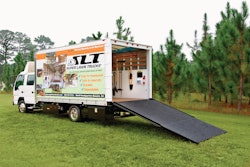Landon Wise has been in business for four years. His customer base and sales volume have grown leaps and bounds. He employs six in peak season. He’s never had a budget—until now.
After spending roughly eight hours with Green Industry consultant Tony Bass of Super Lawn Trucks, Wise developed his first budget for Wyscape Professional Landscaping & Design in Niceville, FL, the company he founded in 2005 after earning his degree in landscape/horticulture from Auburn University.
“My eyes were opened to things I wasn’t even aware of,” Wise says in reference to attending a Tony Bass business seminar a year ago. Then, on December 17, 2009, he met with Bass for a one-on-one consultation. Their mission was to hammer out a budget for 2010. Here’s how they did it.
Create Sub-Categories for Each Major Expense
List each primary area of known overhead expenses, which include:
- Rent/mortgage
- Utilities
- Vehicles/equipment
- Insurance
- Advertising
- Administrative salaries; i.e. office help that isn’t directly “billable” to a client or project
- Office supplies
- Uniforms
Next, break down each major overhead expense category into smaller sub-categories. “Being too broad makes it harder to get your arms around how much to budget,” Bass points out. “You want to be very specific about the individual elements in each major category so you can identify exactly what you intend to spend.”
Advertising is great place to start, especially for smaller companies. For example, consider the following items, and identify how much you want to spend on each in the coming year:
- Yellow Page ad – do you have one, how much per month, do you plan on expanding it this year?
- Newspaper ads – do you plan to run any, how much will it cost?
- Jobsite signs – do any need replacing, how much will that cost?
- Direct mail – do you plan any, how much will it cost?
- Website – do you have one, want to improve it, how much will it cost?
Add all of that up and you have your advertising budget for the year.
“Forcing myself to break things down has really opened my eyes to what my money is really going toward,” Wise relates.
Identify Cost-Saving Opportunities
Breaking expenses down into detailed sub-categories has also opened Wise’s eyes to areas where he can save some money. “Before I had this budget on paper, sometimes I didn’t even know why my money was going there—I just wrote a check,” Wise says with a chuckle. “Now I’m watching everything, and I actually know what to watch for.”
Workers’ comp insurance, a sub-category of “insurance,” is a great example. “There’s a general job code I was listed under, as were each of my employees,” Wise tells. “In reality, my employees could be listed under a different job code that could save me a lot of money. Plus, my estimated payroll was wrong, and that was causing my workers’ comp premiums to be higher than they should be, as well.”
Other sub-categories that often present cost-saving opportunities include cell phones (utilities), vehicle insurance on trucks you no longer need (insurance), and non-production personnel (admin salaries).
“The largest negotiable items are related to labor,” Bass points out. “So before you hire your first non-production worker, such as an office manager, you need a written budget that takes this new expense into consideration.”

















![Gravely Pro Turn Mach One My23 Dsc03139 Edit 1200x800 5b2df79[1]](https://img.greenindustrypros.com/mindful/acbm/workspaces/default/uploads/2025/10/gravely-pro-turn-mach-one-my23-dsc03139-edit-1200x800-5b2df791.BucBnDoN22.jpg?ar=16%3A9&auto=format%2Ccompress&fit=crop&h=135&q=70&w=240)



